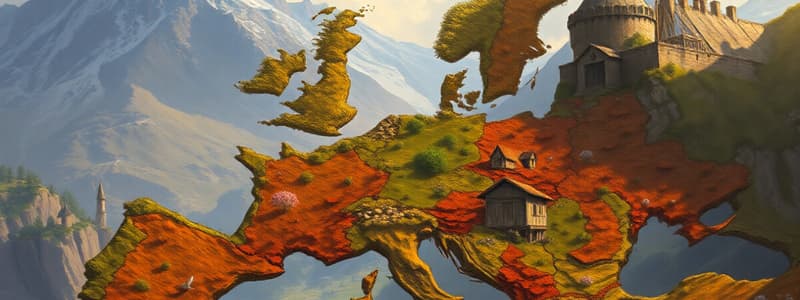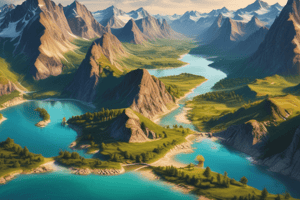Podcast
Questions and Answers
What geographic feature separates Britain and Ireland?
What geographic feature separates Britain and Ireland?
- Mediterranean Sea
- North Sea
- English Channel (correct)
- Irish Sea
Who was the first king of the Franks who accepted Christianity?
Who was the first king of the Franks who accepted Christianity?
- Clovis (correct)
- Charles Martel
- Charlemagne
- Pepin
Which of the following was a significant reason for the fragmentation of Charlemagne's empire after his death?
Which of the following was a significant reason for the fragmentation of Charlemagne's empire after his death?
- Lack of military resources
- Invasion by the Lombards
- Division among his grandsons (correct)
- Religious disputes
What was the primary purpose of guilds in medieval towns?
What was the primary purpose of guilds in medieval towns?
What was the significance of the Concordat of Worms?
What was the significance of the Concordat of Worms?
What role did Archbishop Gregory have in the spread of Christianity in Ireland?
What role did Archbishop Gregory have in the spread of Christianity in Ireland?
Which of the following agricultural advancements helped improve farming efficiency in medieval Europe?
Which of the following agricultural advancements helped improve farming efficiency in medieval Europe?
What was a significant characteristic of feudalism?
What was a significant characteristic of feudalism?
Which group invaded Europe following the death of Charlemagne?
Which group invaded Europe following the death of Charlemagne?
Who crowned Charlemagne as the new Roman Emperor?
Who crowned Charlemagne as the new Roman Emperor?
Flashcards
European Geography
European Geography
Most of Europe is close to the coast, with seas and rivers providing protection from invaders. Mountain ranges like the Pyrenees also shape the geography and culture of the continent.
Frankish Kingdom
Frankish Kingdom
A group of Germanic peoples who settled in modern-day France and western Germany. They converted to Christianity and became a powerful force in Europe.
Charlemagne
Charlemagne
King of the Franks who united much of Western Europe and was crowned Emperor of the Romans. He created a strong centralized government and promoted education and learning.
Viking Invasions
Viking Invasions
Signup and view all the flashcards
Holy Roman Empire
Holy Roman Empire
Signup and view all the flashcards
Church's Authority
Church's Authority
Signup and view all the flashcards
Feudalism
Feudalism
Signup and view all the flashcards
Medieval Knights
Medieval Knights
Signup and view all the flashcards
Medieval Manor
Medieval Manor
Signup and view all the flashcards
Guilds
Guilds
Signup and view all the flashcards
Study Notes
Geography of Europe
- Most of Europe is within 300 miles of a coast.
- Seas and rivers provided protection and influenced culture.
- The English Channel separates Britain and Ireland.
- Mountain ranges, like the Pyrenees, create cultural divisions.
- Western Europe enjoys a mild climate; summers are warm and dry, winters are mild.
- Central and Northern Europe have cold winters and hot summers.
- The growing season is long enough for good harvests.
Kingdoms of Western Europe
- Europe was divided into Germanic kingdoms.
- Italy and Spain retained Roman traditions.
Franks in Europe
- Franks settled in France and Western Germany.
- Clovis became king and converted to Christianity.
- All Franks became Christians.
- Charles Martel gained power, stopped the spread of Islam.
- The Pope supported Martel's actions.
- The Battle of Tours marked a crucial victory for Martel.
- Pepin, Martel's son, took over; defended the Pope from Lombards.
- Pepin gave the Pope Papal estates - strengthened Church-state ties.
Emperor Charlemagne
- Charlemagne, Pepin's son, inherited the throne.
- Charlemagne forcefully converted Saxons to Christianity.
- Charlemagne expanded the Frankish kingdom.
- Charlemagne was known as Charles the Great or Charlemagne.
- Charlemagne defended the Pope.
- He was crowned Roman Emperor, re-establishing the Roman Empire.
- Charlemagne used counts (local officials) for governance.
- He promoted education through the empire.
Waves of Invaders
- Charlemagne's death led to the division of his empire.
- Muslims from Africa raided France and Italy.
- Magyars invaded France.
- Vikings (skilled sailors) raided various regions.
- Vikings were driven by overpopulation and sought new land.
- Vikings seized resources and burned communities.
Holy Roman Empire (HRE)
- German nobles sought unification under a king.
- Otto, a Duke, became ruler and defended the Pope.
- Otto was crowned Emperor of the Romans.
The Church and Its Influence
- St. Patrick traveled to Ireland in the 400s AD, spreading Christianity and establishing churches.
- St. Patrick inspired Pope Gregory I (Greg the Great) to continue spreading Christianity.
- Monks served as missionaries.
- Monks lived in monasteries, serving as schools and hospitals.
- Nuns lived in convents and performed similar roles.
Church Authority
- Conflicts arose between Church leaders and kings regarding authority.
- The Pope claimed authority to appoint high-ranking church officials.
- This angered Emperor Henry IV.
- Pope Gregory VII excommunicated Henry IV.
- German nobles sided with the Pope.
- Henry IV went to the Pope for forgiveness.
- The Pope forgave Henry IV.
- German nobles elected a new king.
- The Pope acknowledged the new king.
- Henry IV seized Rome.
- Disputes continued until 1122, the Concordat of Worms.
- The Concordat of Worms resolved the conflict.
Feudal Order
- Kings granted estates to nobles who fought for them.
- Kings power decreased, landowning nobles gained influence.
- This system is termed Feudalism.
Lord, Vassals, Knights
- Feudalism was based on loyalty and duty.
- Lord: High-ranking noble.
- Vassal: Lower-ranking noble serving a lord in battle.
- Fief: Land granted for service.
- Knight: Warrior who fought on horseback.
Nobles and Knights
- Nobles held significant power in Europe.
- Knights followed a code of chivalry: bravery, obedience, respect, honor, and helping others.
- Knights trained through contests.
- Noble wives or daughters often managed estates.
The Medieval Manor
- Manors were farming communities where peasants and nobles lived and worked.
- A Lord's steward oversaw the manor, ensuring duties.
Two Groups of Peasants
- Peasants were categorized as freemen or serfs.
- Freeman had more rights and could move freely.
- Most peasants were serfs.
- Serfs were tied to the manor and couldn't own property, move, or marry without Lord's permission.
- Serfs couldn't be sold or taken from their land.
- Serfs worked the Lord's land for three days each week.
Life of Peasants
- Peasants lived in simple cottages.
- Lifestyles revolved around the church.
- Sundays and feast days offered breaks.
- Women were responsible for children and food preparation.
Improvements in Farming
- Improvements enhanced farming:
- Heavy Wheeled Plows: More land was available for farming.
- Horse Collars: Horses pulled plows more quickly.
- Water and Wind Power: Used to grind grain.
- Crop Rotation: Three fields were used; soil remained fertile.
Growth of Towns and Cities
- Following the fall of Rome, Europe became dangerous.
- Towns repaired roads, arrested criminals, and enforced laws.
- Population grew; trade with other regions began.
Wealthy Trading Centers
- Trade increased, expanding towns into wealthier cities.
- Venice, Pisa, Genoa became major trading posts.
- Florence produced high-quality wool.
Government in Cities
- A middle class emerged due to growing trade.
- Towns grew large and organized their own governments.
- Cities attempted to avoid paying taxes to nobles.
- Towns forced nobles to grant them rights.
What Do Guilds Do?
- Craftspeople formed guilds to regulate business and trade.
- Guilds set and enforced quality standards.
- Apprentice: Learned from a Master, provided room and board.
- Journeyman: Worked for daily wage under a Master.
- Master: Skilled craftsman.
Life in Medieval Cities
- Cities were walled to keep out invaders.
- Lighting relied on candles and fireplaces; sanitation was poor.
- Unsanitary conditions prevailed in urban settings.
- Women were responsible for child-rearing and support local trade.
Studying That Suits You
Use AI to generate personalized quizzes and flashcards to suit your learning preferences.




